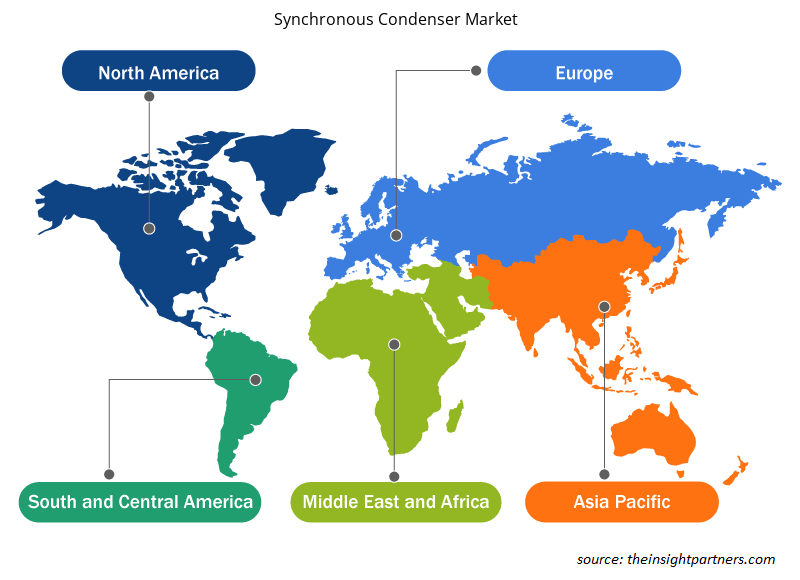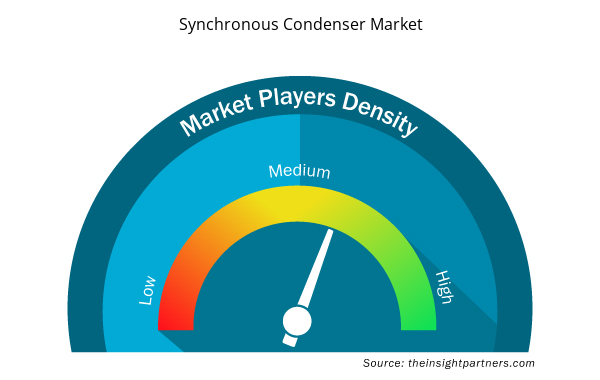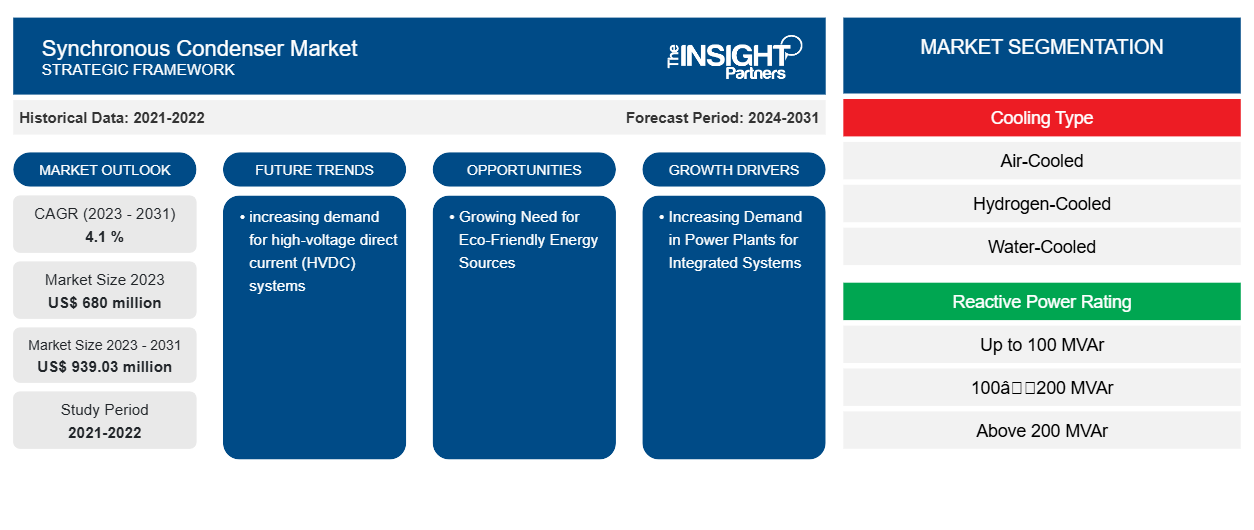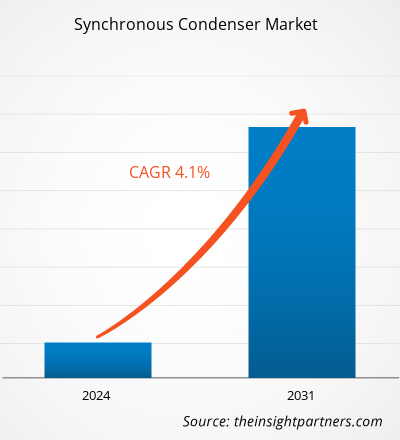Der Markt für Synchronkondensatoren soll von 680 Millionen US-Dollar im Jahr 2023 auf 939,03 Millionen US-Dollar im Jahr 2031 anwachsen. Der Markt soll in den Jahren 2023–2031 eine durchschnittliche jährliche Wachstumsrate von 4,1 % verzeichnen. Die steigende Nachfrage nach Hochspannungs-Gleichstrom-Übertragungssystemen (HGÜ) dürfte ein wichtiger Trend auf dem Markt für Synchronkondensatoren bleiben.
Synchronkondensator Marktanalyse
Der wachsende Bedarf an nachhaltigen Energiequellen treibt den Markt für Synchronkondensatoren weltweit stark voran. Der Markt wächst teilweise aufgrund des steigenden Bedarfs der Kraftwerke an integrierten Systemen. Eine wichtige Chance in diesem Zusammenhang ist die Zunahme staatlicher Programme zur Verringerung der Luftverschmutzung. Der Markt wird jedoch durch Faktoren wie erhöhte Kapital- und Wartungskosten und strenge Vorschriften für Synchronkondensatoren eingeschränkt. Zu den Schwierigkeiten gehören das Vorhandensein kostengünstiger Alternativen und die Notwendigkeit eines komplizierten und langwierigen Installationsverfahrens.
Marktübersicht für Synchronkondensatoren
Synchronkondensatoren sind gleichstromerregte Synchronmotoren, die ihre Leistung und Temperatur entsprechend dem Stromübertragungsnetz verändern. Der Zweck von Synchronkompensatoren, auch Synchronkondensatoren genannt, besteht darin, den Spannungspegel in einem Netzbereich kontinuierlich zu regeln. Abhängig vom Erregerstromwert können sie Blindleistung erzeugen oder verbrauchen. Wenn es um die Leistungsfaktorkorrektur in Stromnetzen geht , bieten Synchronkondensatoren eine Alternative zu Kondensatorbänken.
Passen Sie diesen Bericht Ihren Anforderungen an
Sie erhalten kostenlose Anpassungen an jedem Bericht, einschließlich Teilen dieses Berichts oder einer Analyse auf Länderebene, eines Excel-Datenpakets sowie tolle Angebote und Rabatte für Start-ups und Universitäten.
- Holen Sie sich die wichtigsten Markttrends aus diesem Bericht.Dieses KOSTENLOSE Beispiel umfasst eine Datenanalyse von Markttrends bis hin zu Schätzungen und Prognosen.
Markttreiber und Chancen für Synchronkondensatoren
Steigende Nachfrage in Kraftwerken nach integrierten Systemen
Da das Bewusstsein für erneuerbare Energiequellen wächst, besteht ein wachsender Bedarf an Lösungen, die die Stromqualität und Netzstabilität verbessern können. In Stromsystemen sind Synchronkondensatoren unverzichtbar, da sie die Spannung regulieren und Blindleistung aufrechterhalten. Dank der Integration dieser Kondensatoren bleibt die allgemeine Zuverlässigkeit des Stromerzeugungs- und -verteilungsnetzes erhalten, der Kraftwerksbetrieb wird optimiert und Netzschwankungen werden reduziert. Da der Bedarf an Netzstabilität steigt, wird erwartet, dass der Einsatz von Synchronkondensatoren zunimmt und den Markt vorantreibt.
Wachsender Bedarf an umweltfreundlichen Energiequellen
Der Begriff „saubere Energie“ beschreibt Energie aus Quellen, die keine Luftschadstoffe ausstoßen. Strom aus Ressourcen, die ständig erneuert werden, wird als erneuerbare Energie bezeichnet. Diese nachhaltigen Energiequellen, zu denen Wind- und Sonnenenergie gehören, werden nicht wie fossile Brennstoffe und Gas ausgehen. Nachhaltige Energiequellen sind jedoch größtenteils erneuerbar. Daher sind erneuerbare Energiequellen ein anderer Name für makellose grüne, saubere Energie . Daher wird erwartet, dass der wachsende Bedarf an umweltfreundlichen Energiequellen den Akteuren auf dem Markt für Synchronkondensatoren im Prognosezeitraum neue Möglichkeiten bietet.eco-friendly energy sources is anticipated to present new opportunities for the synchronous condenser market players during the forecast period.
Segmentierungsanalyse des Marktberichts für Synchronkondensatoren
Wichtige Segmente, die zur Ableitung der Marktanalyse für Synchronkondensatoren beigetragen haben, sind Kühltyp, Blindleistungsbewertung, Startmethode und Anwendung.
- Basierend auf der Kühlart ist der Markt für Synchronkondensatoren in luftgekühlt, wasserstoffgekühlt und wassergekühlt unterteilt. Das wasserstoffgekühlte Segment hatte im Jahr 2023 einen größeren Marktanteil.
- Nach Blindleistungsbewertung ist der Markt in bis zu 100 MVAr, 100–200 MVAr und über 200 MVAr segmentiert.
- Nach Startmethode ist der Markt in Kleinmotoren, statische Frequenzumrichter und andere unterteilt.
- Nach Anwendung ist der Markt in Metall und Bergbau, Elektrizitätsversorgungsunternehmen und Netzbetreiber, Schifffahrt, Öl und Gas und Sonstige segmentiert.
Synchronkondensator Marktanteilsanalyse nach Geografie
Der geografische Umfang des Marktberichts für Synchronkondensatoren ist hauptsächlich in fünf Regionen unterteilt: Nordamerika, Asien-Pazifik, Europa, Naher Osten und Afrika sowie Südamerika/Süd- und Mittelamerika. In Bezug auf den Umsatz hatte Europa den größten Marktanteil bei Synchronkondensatoren. Hochspannungs-Gleichstrom-Übertragungssysteme (HGÜ), ein beträchtlicher Kundenstamm, das schnelle Wachstum der Branche für erneuerbare Energien und die Präsenz bedeutender regionaler Unternehmen sind dafür verantwortlich. Darüber hinaus wird erwartet, dass die Existenz von Ländern wie Deutschland, Großbritannien, Frankreich und Spanien die Expansion des europäischen Marktes unterstützen wird.
Regionale Einblicke in den Synchronkondensatormarkt
Die regionalen Trends und Faktoren, die den Markt für Synchronkondensatoren im Prognosezeitraum beeinflussen, wurden von den Analysten von Insight Partners ausführlich erläutert. In diesem Abschnitt werden auch die Marktsegmente und die Geografie von Synchronkondensatoren in Nordamerika, Europa, im asiatisch-pazifischen Raum, im Nahen Osten und Afrika sowie in Süd- und Mittelamerika erörtert.

- Erhalten Sie regionale Daten zum Synchronkondensatormarkt
Umfang des Marktberichts über Synchronkondensatoren
| Berichtsattribut | Details |
|---|---|
| Marktgröße im Jahr 2023 | 680 Millionen US-Dollar |
| Marktgröße bis 2031 | 939,03 Millionen US-Dollar |
| Globale CAGR (2023 - 2031) | 4,1 % |
| Historische Daten | 2021-2022 |
| Prognosezeitraum | 2024–2031 |
| Abgedeckte Segmente | Nach Kühlart
|
| Abgedeckte Regionen und Länder | Nordamerika
|
| Marktführer und wichtige Unternehmensprofile |
|
Marktteilnehmerdichte: Der Einfluss auf die Geschäftsdynamik
Der Markt für Synchronkondensatoren wächst rasant, angetrieben durch die steigende Nachfrage der Endnutzer aufgrund von Faktoren wie sich entwickelnden Verbraucherpräferenzen, technologischen Fortschritten und einem größeren Bewusstsein für die Vorteile des Produkts. Mit steigender Nachfrage erweitern Unternehmen ihr Angebot, entwickeln Innovationen, um die Bedürfnisse der Verbraucher zu erfüllen, und nutzen neue Trends, was das Marktwachstum weiter ankurbelt.
Die Marktteilnehmerdichte bezieht sich auf die Verteilung von Firmen oder Unternehmen, die in einem bestimmten Markt oder einer bestimmten Branche tätig sind. Sie gibt an, wie viele Wettbewerber (Marktteilnehmer) in einem bestimmten Marktraum im Verhältnis zu seiner Größe oder seinem gesamten Marktwert präsent sind.
Die wichtigsten auf dem Markt für Synchronkondensatoren tätigen Unternehmen sind:
- ABB Ltd.
- BRUSH-Gruppe
- Eaton Corporation PLC
- Fuji Electric Co., Ltd.
- Allgemeine Elektrik
- Hyundai Idela Electric Co.
Haftungsausschluss : Die oben aufgeführten Unternehmen sind nicht in einer bestimmten Reihenfolge aufgeführt.

- Erhalten Sie einen Überblick über die wichtigsten Akteure auf dem Markt für Synchronkondensatoren
Nachrichten und aktuelle Entwicklungen zum Synchronkondensatormarkt
Der Markt für Synchronkondensatoren wird durch die Erhebung qualitativer und quantitativer Daten nach Primär- und Sekundärforschung bewertet, die wichtige Unternehmensveröffentlichungen, Verbandsdaten und Datenbanken umfasst. Im Folgenden finden Sie eine Liste der Entwicklungen auf dem Markt für Sprach- und Sprechstörungen und Strategien:
- Im November 2023 stellte Siemens an der Shannon Bridge B in Irland ein hybrides Netzstabilisierungssystem vor. Dieses neuartige Gerät kombiniert eine 160-MWh-Batterie mit einem mit Schwungrad ausgestatteten Synchronkondensator. Dies ist das erste Mal, dass diese beiden Technologien kombiniert wurden, um eine einzige, zusammenhängende Netzanschlusslösung bereitzustellen. Die Verbesserung der Netzstabilität und die Optimierung der Nutzung erneuerbarer Energiequellen sind die Hauptziele. Siemens hofft, Netzprobleme erfolgreich zu bewältigen und den Übergang zu einer nachhaltigeren Energieinfrastruktur durch den Einsatz dieser hochmodernen Hybridlösung zu beschleunigen. (Quelle: Siemens, Pressemitteilung)
- Im November 2023 gab General Electric bekannt, dass EDF SEI ein Konsortium aus der Abteilung Power Conversion von GE Vernova und Eiffage Énergie Systèmes (Konsortialführer) ausgewählt hat, um ein schlüsselfertiges Synchronkondensatorsystem für die EDF bereitzustellen und zu bauen. (Quelle: General Electric, Pressemitteilung)
Marktbericht zu Synchronkondensatoren – Abdeckung und Ergebnisse
Der Bericht „Marktgröße und Prognose für Synchronkondensatoren (2021–2031)“ bietet eine detaillierte Analyse des Marktes, die die folgenden Bereiche abdeckt:
- Marktgröße und Prognose auf globaler, regionaler und Länderebene für alle wichtigen Marktsegmente, die im Rahmen des Projekts abgedeckt sind
- Marktdynamik wie Treiber, Beschränkungen und wichtige Chancen
- Wichtige Zukunftstrends
- Detaillierte PEST/Porters Five Forces- und SWOT-Analyse
- Globale und regionale Marktanalyse mit wichtigen Markttrends, wichtigen Akteuren, Vorschriften und aktuellen Marktentwicklungen
- Branchenlandschaft und Wettbewerbsanalyse, einschließlich Marktkonzentration, Heatmap-Analyse, prominenten Akteuren und aktuellen Entwicklungen
- Detaillierte Firmenprofile
- Historische Analyse (2 Jahre), Basisjahr, Prognose (7 Jahre) mit CAGR
- PEST- und SWOT-Analyse
- Marktgröße Wert/Volumen – Global, Regional, Land
- Branche und Wettbewerbsumfeld
- Excel-Datensatz



Report Coverage
Revenue forecast, Company Analysis, Industry landscape, Growth factors, and Trends

Segment Covered
This text is related
to segments covered.

Regional Scope
North America, Europe, Asia Pacific, Middle East & Africa, South & Central America

Country Scope
This text is related
to country scope.
Häufig gestellte Fragen
The global synchronous condenser market was estimated to be US$ 680 million in 2023 and is expected to grow at a CAGR of 4.1 % during the forecast period 2023 - 2031.
The increasing demand in power plants for integrated systems and the growing need for eco-friendly energy sources are the major factors that propel the global synchronous condenser market.
The increasing demand for high-voltage direct current (HVDC) systems is anticipated to play a significant role in the global synchronous condenser market in the coming years.
The key players holding majority shares in the global synchronous condenser market are ABB Ltd., BRUSH Group, Eaton Corporation PLC, Fuji Electric Co., Ltd., and General Electric.
The global synchronous condenser market is expected to reach US$ 939.03 million by 2031.
The Insight Partners performs research in 4 major stages: Data Collection & Secondary Research, Primary Research, Data Analysis and Data Triangulation & Final Review.
- Data Collection and Secondary Research:
As a market research and consulting firm operating from a decade, we have published and advised several client across the globe. First step for any study will start with an assessment of currently available data and insights from existing reports. Further, historical and current market information is collected from Investor Presentations, Annual Reports, SEC Filings, etc., and other information related to company’s performance and market positioning are gathered from Paid Databases (Factiva, Hoovers, and Reuters) and various other publications available in public domain.
Several associations trade associates, technical forums, institutes, societies and organization are accessed to gain technical as well as market related insights through their publications such as research papers, blogs and press releases related to the studies are referred to get cues about the market. Further, white papers, journals, magazines, and other news articles published in last 3 years are scrutinized and analyzed to understand the current market trends.
- Primary Research:
The primarily interview analysis comprise of data obtained from industry participants interview and answers to survey questions gathered by in-house primary team.
For primary research, interviews are conducted with industry experts/CEOs/Marketing Managers/VPs/Subject Matter Experts from both demand and supply side to get a 360-degree view of the market. The primary team conducts several interviews based on the complexity of the markets to understand the various market trends and dynamics which makes research more credible and precise.
A typical research interview fulfils the following functions:
- Provides first-hand information on the market size, market trends, growth trends, competitive landscape, and outlook
- Validates and strengthens in-house secondary research findings
- Develops the analysis team’s expertise and market understanding
Primary research involves email interactions and telephone interviews for each market, category, segment, and sub-segment across geographies. The participants who typically take part in such a process include, but are not limited to:
- Industry participants: VPs, business development managers, market intelligence managers and national sales managers
- Outside experts: Valuation experts, research analysts and key opinion leaders specializing in the electronics and semiconductor industry.
Below is the breakup of our primary respondents by company, designation, and region:

Once we receive the confirmation from primary research sources or primary respondents, we finalize the base year market estimation and forecast the data as per the macroeconomic and microeconomic factors assessed during data collection.
- Data Analysis:
Once data is validated through both secondary as well as primary respondents, we finalize the market estimations by hypothesis formulation and factor analysis at regional and country level.
- Macro-Economic Factor Analysis:
We analyse macroeconomic indicators such the gross domestic product (GDP), increase in the demand for goods and services across industries, technological advancement, regional economic growth, governmental policies, the influence of COVID-19, PEST analysis, and other aspects. This analysis aids in setting benchmarks for various nations/regions and approximating market splits. Additionally, the general trend of the aforementioned components aid in determining the market's development possibilities.
- Country Level Data:
Various factors that are especially aligned to the country are taken into account to determine the market size for a certain area and country, including the presence of vendors, such as headquarters and offices, the country's GDP, demand patterns, and industry growth. To comprehend the market dynamics for the nation, a number of growth variables, inhibitors, application areas, and current market trends are researched. The aforementioned elements aid in determining the country's overall market's growth potential.
- Company Profile:
The “Table of Contents” is formulated by listing and analyzing more than 25 - 30 companies operating in the market ecosystem across geographies. However, we profile only 10 companies as a standard practice in our syndicate reports. These 10 companies comprise leading, emerging, and regional players. Nonetheless, our analysis is not restricted to the 10 listed companies, we also analyze other companies present in the market to develop a holistic view and understand the prevailing trends. The “Company Profiles” section in the report covers key facts, business description, products & services, financial information, SWOT analysis, and key developments. The financial information presented is extracted from the annual reports and official documents of the publicly listed companies. Upon collecting the information for the sections of respective companies, we verify them via various primary sources and then compile the data in respective company profiles. The company level information helps us in deriving the base number as well as in forecasting the market size.
- Developing Base Number:
Aggregation of sales statistics (2020-2022) and macro-economic factor, and other secondary and primary research insights are utilized to arrive at base number and related market shares for 2022. The data gaps are identified in this step and relevant market data is analyzed, collected from paid primary interviews or databases. On finalizing the base year market size, forecasts are developed on the basis of macro-economic, industry and market growth factors and company level analysis.
- Data Triangulation and Final Review:
The market findings and base year market size calculations are validated from supply as well as demand side. Demand side validations are based on macro-economic factor analysis and benchmarks for respective regions and countries. In case of supply side validations, revenues of major companies are estimated (in case not available) based on industry benchmark, approximate number of employees, product portfolio, and primary interviews revenues are gathered. Further revenue from target product/service segment is assessed to avoid overshooting of market statistics. In case of heavy deviations between supply and demand side values, all thes steps are repeated to achieve synchronization.
We follow an iterative model, wherein we share our research findings with Subject Matter Experts (SME’s) and Key Opinion Leaders (KOLs) until consensus view of the market is not formulated – this model negates any drastic deviation in the opinions of experts. Only validated and universally acceptable research findings are quoted in our reports.
We have important check points that we use to validate our research findings – which we call – data triangulation, where we validate the information, we generate from secondary sources with primary interviews and then we re-validate with our internal data bases and Subject matter experts. This comprehensive model enables us to deliver high quality, reliable data in shortest possible time.


 Holen Sie sich ein kostenloses Muster für diesen Bericht
Holen Sie sich ein kostenloses Muster für diesen Bericht